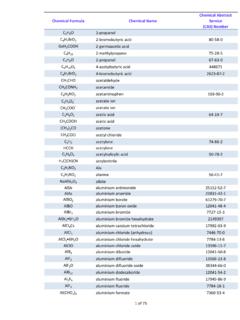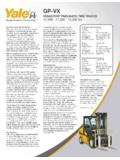Transcription of JARS & JAR W & D S EDUCTION Since 1911 - Paul O. Abbe
1 PAUL O. ABBE Jars and Jar Rolling Mills have been used for wet and dry milling for over 100 years in labs around the world. Even Thomas A. Edison recognized the advantages of ABBE Milling Jars and utilized them at his Menlo Park laboratory. Today, the same tumble milling principles are utilized for size reduction of ceramics, semi-conductors, rare-earth metals, mineral assay, nutraceuticals, pharmaceuticals, cosmetics and general of Tumble Milling: FINE PARTICLES & NARROW DISTRIBUTION - Tumble milling takes place over a controlled period of time and results in both fi ne particle size and narrow size distribution.
2 MILL & DISPERSE - When wet milling, solids are both size reduced and dispersed in the liquid medium. LOW TEMPERATURE - Tumble milling avoids temperature spikes by putting more energy into milling and less into unwanted frictional heat. LOW CONTAMINATION - The energy effi cient impact of media results in less media-to-media friction and less product contamination. CONTROLLABLE - Variables including rotational speed, media size and milling duration can be independently controlled with predictable effects on milling results. PREDICTABLE SCALE-UP - Scale-up from small to larger mills is predictable.
3 Tumble milling is one of the few unit operations that actually improves with increasing size. Engineered to Perform and Last: ABBE Jar Rolling Mills are industrial grade machines designed to operate continuously for many years. ABBE Jar Rolling Mills have no equivalent in laboratory supply catalogs. Every roll is manufactured from steel with a thick polyurethane outer layer which is machined for concentricity and smooth operation. Each roll end is supported by industrial roller bearings mounted on a heavy-duty welded steel frame with chemical and corrosion resistant epoxy or powder coating. Roll space in adjustable to accommodate different size ABBE jars.
4 The exclusive modular design allows for the addition up to four tiers after installation with common Jar Rolling Mill Designs: Roller lengths: 36 , 48 or 60 Number of tiers: 1, 2, 3 or 4 Number of rollers per tier: 2, 3, 4 or 5 Variable speed drive and tachometer Options: Digital shut-off timerSound deadening enclosuresStainless steel frameExplosion-proof motors & controlsIndependent speed controls for each tier - Scale-up from small to larger mills is predictable. Tumble milling is one of the few unit operations - Scale-up from small to larger mills is predictable. Tumble milling is one of the few unit operations 1911 Abbe Jar in Edison LabABBE Milling Jars are available in alumina fortifi ed ceramic, stainless steel, carbon steel, nylon, polyurethane & rubber page 4 for jar capacities and period of time and results in both fi ne particle size and narrow size distribution.
5 Are both size reduced and dispersed in the liquid speed, media size and milling duration can be independently controlled with predictable effects on milling results. PREDICTABLE SCALE-UPmills is predictable. Tumble milling is one of the few unit operations Laboratory Jar Rolling Mill with variable speed drive, tachometer (Ceramic Jar optional) Standard electrics 110 volt, single phase, 60 : 2 diameter x 24 long, 3 rolls Jarsin alumina fortifi ed ceramic, stainless steel, carbon steel, nylon, polyurethane & See page 4 for jar Milling Jarsare available in alumina fortifi ed ceramic, stainless steel, carbon steel, nylon, polyurethane & Original Abbe Jarpage 1 JARS & JAR ROLLING MILLS WET & DRY SIZE REDUCTIONJH with the Experts_____Since 1911phone fax Jar Rolling Mill (benchtop design) Rollers.
6 Machined polyurethane over steel rollers: 2 diameter x 24 long rolls 2 roller bearings supporting each roll 2 rolls standard (3 rolls optional) adjustable roller spacingSupport Frame: formed and welded steel rotating nylon jar stops white epoxy coatingDrive: HP DC drive quite belt drive roller speed 25-510 rpm Controls: start/stop push buttons forward/reverse toggle switch speed control rpm display (reading directly off roller) 110 volt, single phase, 60 Hz. NEMA-12 enclosure (optional) shut-off timerDimensions: length 37 , depth , height weight 140 poundsModular Jar Rolling MillS Rollers: machined polyurethane over steel diameter rollers (36 & 48 lengths) 3 diameter rollers (60 length) 2 roller bearings supporting each roll end 2 rolls per tier standard (3, 4 or 5 rolls optional) adjustable roller spacingSupport Frame: formed and welded steel rotating nylon jar stops tan epoxy or powder coatingDrive: 2 HP AC drive gear reducer and chain & sprocket roller speed 35-350 rpm Controls.
7 Start/stop push buttons forward/reverse toggle switch speed control rpm display (reading directly off roller) 230 volt, 3-phase, 60 Hz NEMA-12 enclosureOptions (see next page for examples)Rollers: stainless steel rolls for solvent resistance 3, 4 or 5 rolls per tier 2, 3 or 4 tiers (tiers are modular and can be added even after installation)Support Frame: all stainless steel frame sound enclosureDrive: independent drive & speed controls on each tier direct drive gear reducer (eliminates chain drives) all driven rollers (no idler rolls) Controls: shut-off timer NEMA-4X wash down NEMA-7&9 explosion proof 460 volt, 3-phase, 60 HzPolyurethane lined jars are lightweight, abrasion resistant and quite - a great alternative to steel or ceramic jars.
8 Liners are easily replaced. See page 4 for all jar 2 JARS & JAR ROLLING MILLS WET & DRY SIZE REDUCTIONJH with the Experts_____Since 1911phone fax , 3 rollers per tier with explosion proof NEMA-7&9 steel 2-tier, 2 rollers per Enclosure - Stainless steel frame, 2-tier, 3 rollers per tier with explosion proof NEMA-7&9 Enclosure - 3-tiers, 2 rollers per tier with explosion proof NEMA-7&9 direct coupled right-angle gear drives and separate speed controls and RPM readout for each direct coupled Independent direct coupled Synchronized Rollers:All 20 rollers on 4 tiers are driven at same speed from a single 3 JARS & JAR ROLLING MILLS FOR WET & DRY SIZE REDUCTIONJH with the Experts_____Since 1911phone fax (40%) Reinforce Porcelain Jars (no lifters)WeightUSGL iters *based on 1/2" mediaAbbethane Jars - Polyurethane Liner (cast in lifters)replaceable linerWeightUSGL iters *based on 1/2" mediaNylon Jars (no lifters)WeightUSGL iters *based on 1/2" mediaStainless Steel Jars (lifters optional)Carbon Steel Jars (lifters optional)Buna Rubber Lined Carbon Steel Jars (lifters optional)
9 WeightUSGL iters *based on 1/2" mediaTotal VolumeDimensionsPercent of Critical Speed*Percent of Critical Speed*Percent of Critical Speed*Percent of Critical Speed*DimensionsTotal VolumeTotal VolumeDimensionsTotal VolumeDimensionsCapacities and dimensions are approximate and may change without notice - grinding media not 4 JARS & JAR ROLLING MILLS FOR WET & DRY SIZE REDUCTIONJH with the Experts_____Since 1911phone fax and Roller RPM Calculations1) Determine Jar Critical Speed: Critical Speed = Functional Inside Diameter2) Determine Jar RPM: (a range of Jar rpm s are listed on the previous page) To detemine Jar RPM, multiply the Critical Speed from #1 above by to Jar RPM Guidlines: Optimal Speed (55% to 75% of ) will provide effi cient tumbling and cascading of media producing consistent and effi cient size reduction.
10 Low Speed (<55% of ) will result in media slippage, especially if there are no lifter bars, resulting in poor milling and increased shell and media wear. High Speed (>75% of ) will cause the media to be thrown inside the mill, impacting each other and the mill shell ( , caratacting). This will increase milling intensity but will greatly increase media and shell wear. (Higher speeds are used for metal fl aking where hammering and fl attening of ductile metals are desired).3) Determine Roller RPM (to obtain Jar RPM from #2 above):Roller RPM = Jar RPM X (Jar outside diameter) Roller diameterRoller Diameters: 2 24 lab model 36 & 48 long rolls 3 60 long rollsOther calculation.






